
views
Mixing Up Essential Oil Cat Repellent

Add the essential oil to a spray bottle. For the repellent, you’ll need a 2-ounce (59 ml) glass spray bottle. Squeeze 2 drops of lemon essential oil, 2 drops of wild orange essential oil, and 2 drops of lavender essential oil to the bottle. Cats are more sensitive to scents than humans, so essential oils with strong odors, such as citrus and lavender, can help repel them. You can substitute lime, peppermint, and/or eucalyptus for the lemon, wild orange, and lavender if you prefer. It’s important to use a glass bottle for the spray because essential oils degrade more easily in a plastic bottle.
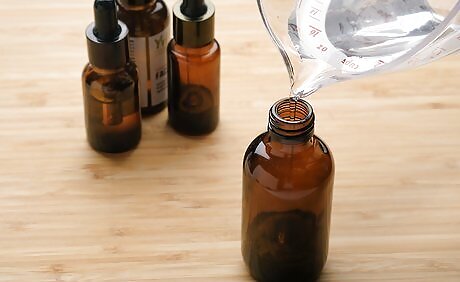
Fill the spray bottle with water and shake it well to mix. After you’ve added the essential oils to the spray bottle, pour enough water in to fill it. Close the bottle securely, and shake it well to ensure that the oils are blended with the water. It isn’t necessary to use filtered or purified water for the spray. Regular tap water works fine.
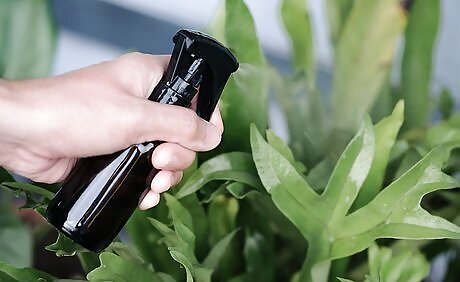
Spray the mixture on desired locations. Once the water and oils are mixed, apply the cat repellent to areas that you want to discourage cats from visiting. In particular, it works well if you have house plants that you want to keep cats away from. Be careful spraying the repellent on carpeting, curtains, or other fabrics because the oils may stain the material. Test it on an inconspicuous spot on the fabric to ensure that the spray won’t damage it.
Preparing Vinegar Cat Repellent
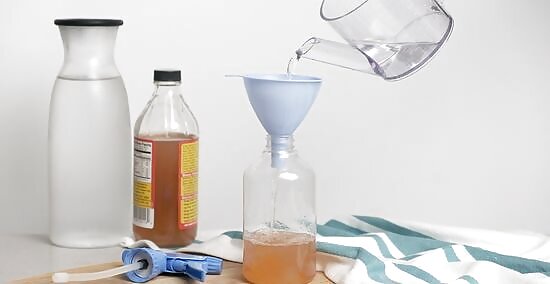
Add the vinegar and water to a spray bottle. For the cat repellent, you’ll need a spray bottle. Pour 1 part vinegar and 1 part water into the bottle, and swish them together quickly to blend them. Use white vinegar for the spray. You can use tap, filtered, purified, or bottled water for the repellent. You can use either a plastic or glass spray bottle for repellent.
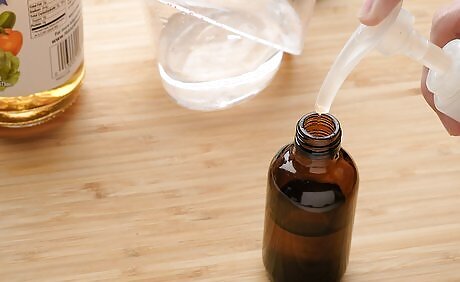
Pour the soap into the bottle and shake the mixture well. When the vinegar and water are mixed, squeeze 1 part liquid hand soap into the spray bottle. Shake the mixture vigorously to ensure that the soap is fully combined with the vinegar mixture. Any type of hand soap will work for the repellent, but it’s best to use a clear formula.
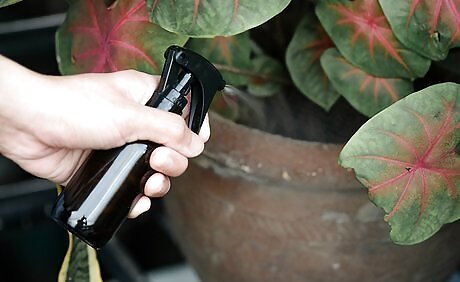
Spray or wipe the mixture on targeted areas. Once the vinegar, water, and soap are fully mixed together, apply on the areas where you want to discourage cats from going. You can spray it directly from the bottle or apply it to a cloth and wipe it over the spots. You can use the repellent to keep cats away from both indoor and outdoor locations.
Whipping Up Citrus Cat Repellent
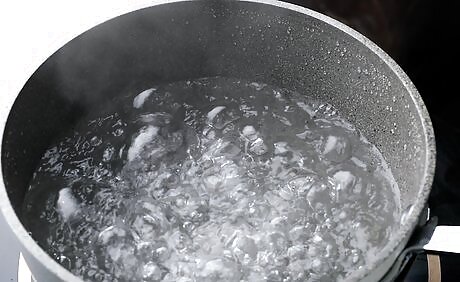
Boil the water. Add 2 cups (473 ml) water to a medium pot. Heat the water over medium-high to high heat until it comes to a boil, which should take 5 to 7 minutes. Because you’re boiling it, tap water is fine for the repellent.
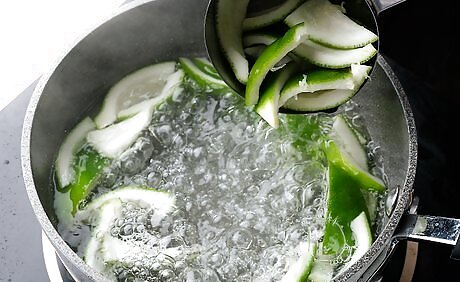
Mix in the citrus peels and simmer the mixture. Once the water comes to a boil, add 1 cup (96 g) of orange, lemon, lime, and/or tangerine peels to the pot. Lower the heat to medium, and allow the mixture to simmer for 20 minutes. Cat dislike citrus scents, so any combination of orange, lemon, lime, and/or tangerine peels that totals a cup (96 g) will work for the repellent. If the mixture begins to boil again, lower the heat.
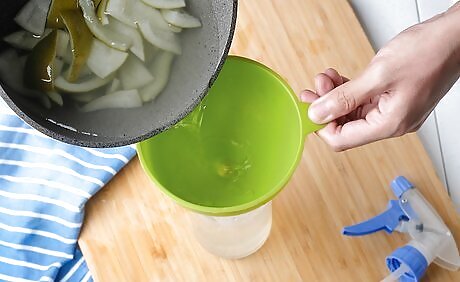
Allow the mixture to cool and transfer the mixture to a spray bottle. After the mixture has simmered for 20 minutes, take the pot off the heat. Let the mixture cool completely, which should take approximately 30 minutes, before transferring it to a spray bottle. If the citrus peels are in large chunks, you can strain them out of the mixture so it’s easier to pour into the bottle.
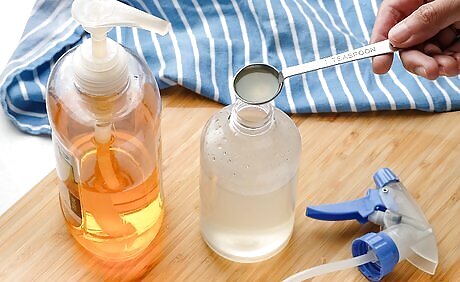
Add the lemon juice and dish soap and shake well to mix. When the mixture is in the spray bottle, pour 2 teaspoons (10 ml) of lemon juice and a squirt or two of lemon-scented dish soap. Shake the bottle well to ensure that all of the ingredients are well combined. You can substitute lime or orange juice for the lemon, but be sure to use freshly squeezed juice. You can use any type of clear dish soap, but a lemon-scented formula works best because cats don’t like the citrus scent.
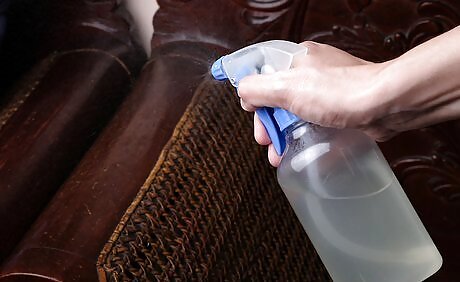
Apply the mixture to key areas in your home. After you’ve thoroughly mixed the ingredients, spray the mixture in any area of your house that you want to keep cats out of. You can apply it to floors, walls, and even furniture. To be safe, it’s best to test the repellent on an inconspicuous spot on fabric-covered items to ensure that the ingredients won’t damage the material.
Creating Citronella Oil Cat Repellent
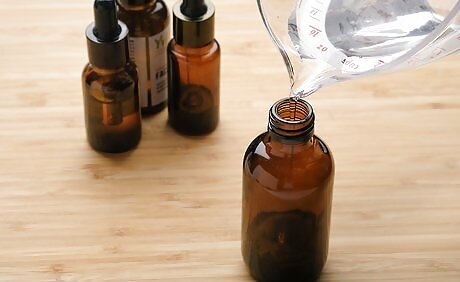
Fill a spray bottle with the water. For the cat repellent, you’ll need a glass spray bottle. Add enough water to the bottle to almost fill it all the way to the top. Tap, filtered, purified, and bottled water will all work for the repellent. Using a glass spray bottle helps keep the repellent effect because the oil is more likely to break down in a plastic container.
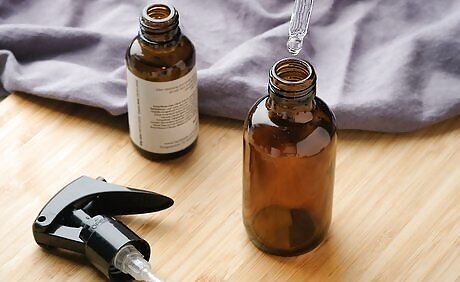
Add the citronella oil to the bottle and shake it well. After you’ve nearly filled the bottle with water, squeeze 20 drops of citronella oil into it. Mix the oil into the water by shaking the bottle well. Like citrus and other essential oils, citronella oil has an extremely strong odor that repels cats. It is also effective in keeping insects away.

Spray the mixture in indoor and outdoor locations. Once you’ve mixed the citronella oil and water fully, apply the mixture to any locations that you wish to keep cats away from. You can use it in both indoor and outdoor locations, though it’s important to reapply regularly outdoors if it rains. If you are using the citronella repellent in an area where cats have gone to the bathroom, it’s important to clean the spot thoroughly before applying the repellent.
Putting Together Garlic, Pepper, and Lemon Cat Repellent
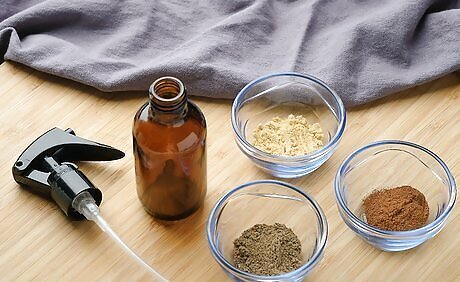
Combine the pepper, mustard, and cinnamon in a spray bottle. For the cat repellent, you’ll need a 2-ounce (59 ml) glass spray bottle. Add 1 teaspoon (2 g) of black pepper, 1 teaspoon (2 g) of dry mustard, and 1 teaspoon (3 g) of cinnamon to the bottle. You can substitute cayenne pepper for the black if you prefer.
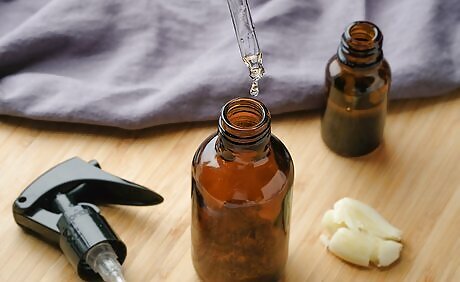
Add the essential oil and garlic. After you’ve added the spices to the spray bottle, toss in a crushed garlic clove. Next, squeeze in 3 to 4 drops of lemon essential oil, and swish the contents gently to combine them. You can substitute ⅛ teaspoon (½ g) of garlic powder for the clove. Lime, wild orange, or grapefruit essential oil will work in place of the lemon.
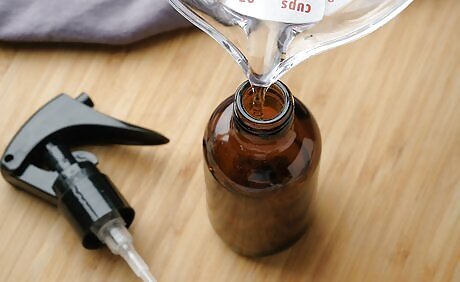
Fill the bottle with water and mix well. Once all of the spices and oil are in the bottle, add enough water to fill the container. Shake the bottle vigorously to completely blend all of the ingredients. Tap water will work well for the repellent.
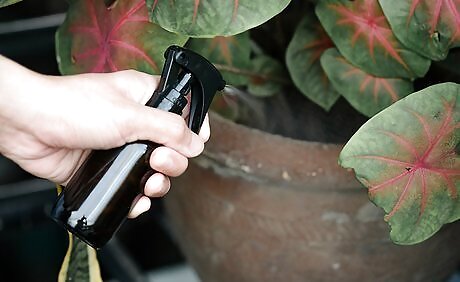
Apply the mixture to preferred outdoor areas. When the spray is fully mixed, spray it over any outdoor locations that you wish to keep cats away from. In particular, it works well for garden beds, bushes, and other plants. You can also use the repellent to keep cats away from indoor plants.



















Comments
0 comment